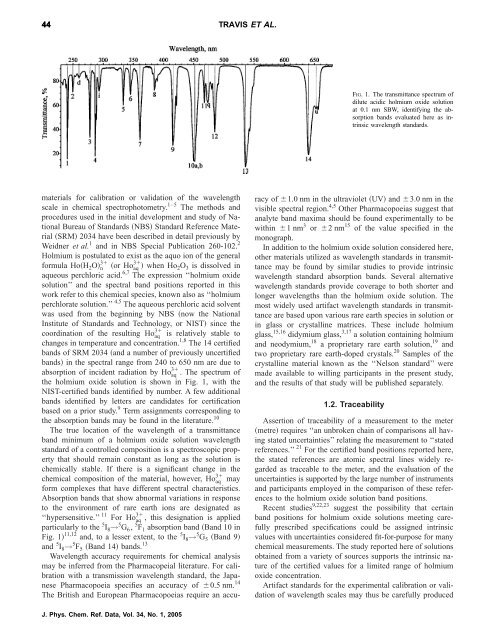Intrinsic Wavelength Standard Absorption Bands in Holmium Oxide ...
Intrinsic Wavelength Standard Absorption Bands in Holmium Oxide ...
Intrinsic Wavelength Standard Absorption Bands in Holmium Oxide ...
Create successful ePaper yourself
Turn your PDF publications into a flip-book with our unique Google optimized e-Paper software.
44 TRAVIS ET AL.<br />
materials for calibration or validation of the wavelength<br />
scale <strong>in</strong> chemical spectrophotometry. 1–5 The methods and<br />
procedures used <strong>in</strong> the <strong>in</strong>itial development and study of National<br />
Bureau of <strong>Standard</strong>s NBS <strong>Standard</strong> Reference Material<br />
SRM 2034 have been described <strong>in</strong> detail previously by<br />
Weidner et al. 1 and <strong>in</strong> NBS Special Publication 260-102. 2<br />
<strong>Holmium</strong> is postulated to exist as the aquo ion of the general<br />
3 3<br />
formula HoH2On or Hoaq when Ho2O3 is dissolved <strong>in</strong><br />
aqueous perchloric acid. 6,7 The expression ‘‘holmium oxide<br />
solution’’ and the spectral band positions reported <strong>in</strong> this<br />
work refer to this chemical species, known also as ‘‘holmium<br />
perchlorate solution.’’ 4,5 The aqueous perchloric acid solvent<br />
was used from the beg<strong>in</strong>n<strong>in</strong>g by NBS now the National<br />
Institute of <strong>Standard</strong>s and Technology, or NIST s<strong>in</strong>ce the<br />
3<br />
coord<strong>in</strong>ation of the result<strong>in</strong>g Hoaq is relatively stable to<br />
changes <strong>in</strong> temperature and concentration. 1,8 The 14 certified<br />
bands of SRM 2034 and a number of previously uncertified<br />
bands <strong>in</strong> the spectral range from 240 to 650 nm are due to<br />
3<br />
absorption of <strong>in</strong>cident radiation by Hoaq . The spectrum of<br />
the holmium oxide solution is shown <strong>in</strong> Fig. 1, with the<br />
NIST-certified bands identified by number. A few additional<br />
bands identified by letters are candidates for certification<br />
based on a prior study. 9 Term assignments correspond<strong>in</strong>g to<br />
the absorption bands may be found <strong>in</strong> the literature. 10<br />
The true location of the wavelength of a transmittance<br />
band m<strong>in</strong>imum of a holmium oxide solution wavelength<br />
standard of a controlled composition is a spectroscopic property<br />
that should rema<strong>in</strong> constant as long as the solution is<br />
chemically stable. If there is a significant change <strong>in</strong> the<br />
3<br />
chemical composition of the material, however, Hoaq may<br />
form complexes that have different spectral characteristics.<br />
<strong>Absorption</strong> bands that show abnormal variations <strong>in</strong> response<br />
to the environment of rare earth ions are designated as<br />
‘‘hypersensitive.’’ 11 3<br />
For Hoaq , this designation is applied<br />
particularly to the 5I8→5G6, 5F1 absorption band Band 10 <strong>in</strong><br />
Fig. 1 11,12 and, to a lesser extent, to the 5I8→5G5 Band 9<br />
and 5I8→5F5 Band 14 bands. 13<br />
<strong>Wavelength</strong> accuracy requirements for chemical analysis<br />
may be <strong>in</strong>ferred from the Pharmacopeial literature. For calibration<br />
with a transmission wavelength standard, the Japanese<br />
Pharmacopoeia specifies an accuracy of 0.5 nm. 14<br />
The British and European Pharmacopoeias require an accu-<br />
J. Phys. Chem. Ref. Data, Vol. 34, No. 1, 2005<br />
FIG. 1. The transmittance spectrum of<br />
dilute acidic holmium oxide solution<br />
at 0.1 nm SBW, identify<strong>in</strong>g the absorption<br />
bands evaluated here as <strong>in</strong>tr<strong>in</strong>sic<br />
wavelength standards.<br />
racy of 1.0 nm <strong>in</strong> the ultraviolet UV and 3.0 nm <strong>in</strong> the<br />
visible spectral region. 4,5 Other Pharmacopoeias suggest that<br />
analyte band maxima should be found experimentally to be<br />
with<strong>in</strong> 1 nm 3 or 2 nm 15 of the value specified <strong>in</strong> the<br />
monograph.<br />
In addition to the holmium oxide solution considered here,<br />
other materials utilized as wavelength standards <strong>in</strong> transmittance<br />
may be found by similar studies to provide <strong>in</strong>tr<strong>in</strong>sic<br />
wavelength standard absorption bands. Several alternative<br />
wavelength standards provide coverage to both shorter and<br />
longer wavelengths than the holmium oxide solution. The<br />
most widely used artifact wavelength standards <strong>in</strong> transmittance<br />
are based upon various rare earth species <strong>in</strong> solution or<br />
<strong>in</strong> glass or crystall<strong>in</strong>e matrices. These <strong>in</strong>clude holmium<br />
glass, 15,16 didymium glass, 3,17 a solution conta<strong>in</strong><strong>in</strong>g holmium<br />
and neodymium, 18 a proprietary rare earth solution, 19 and<br />
two proprietary rare earth-doped crystals. 20 Samples of the<br />
crystall<strong>in</strong>e material known as the ‘‘Nelson standard’’ were<br />
made available to will<strong>in</strong>g participants <strong>in</strong> the present study,<br />
and the results of that study will be published separately.<br />
1.2. Traceability<br />
Assertion of traceability of a measurement to the meter<br />
metre requires ‘‘an unbroken cha<strong>in</strong> of comparisons all hav<strong>in</strong>g<br />
stated uncerta<strong>in</strong>ties’’ relat<strong>in</strong>g the measurement to ‘‘stated<br />
references.’’ 21 For the certified band positions reported here,<br />
the stated references are atomic spectral l<strong>in</strong>es widely regarded<br />
as traceable to the meter, and the evaluation of the<br />
uncerta<strong>in</strong>ties is supported by the large number of <strong>in</strong>struments<br />
and participants employed <strong>in</strong> the comparison of these references<br />
to the holmium oxide solution band positions.<br />
Recent studies 9,22,23 suggest the possibility that certa<strong>in</strong><br />
band positions for holmium oxide solutions meet<strong>in</strong>g carefully<br />
prescribed specifications could be assigned <strong>in</strong>tr<strong>in</strong>sic<br />
values with uncerta<strong>in</strong>ties considered fit-for-purpose for many<br />
chemical measurements. The study reported here of solutions<br />
obta<strong>in</strong>ed from a variety of sources supports the <strong>in</strong>tr<strong>in</strong>sic nature<br />
of the certified values for a limited range of holmium<br />
oxide concentration.<br />
Artifact standards for the experimental calibration or validation<br />
of wavelength scales may thus be carefully produced
















